The topic for the talk at our meeting on 22 January 2025 was Choosing a Telescope and the talk was given by members of the Society. After an introduction by our Programme Secretary Tony Sizer, the basic principles of how a telescope works were explained. This included the way light Is refracted through converging and diverging lenses; the effects of chromatic and other aberrations; the way these aberrations can be corrected and how concave and convex mirrors are used in reflector telescopes.
Different types of telescopes were then described and each was on display at the front of the hall. Binoculars were also covered. Each member involved in the talk referred to one item and highlighted its main features and any pros and cons, as summarised below.
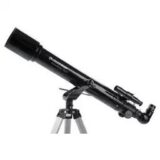 1. Basic Refractor with Altazimuth Mount – Celestron 70mm Refractor
1. Basic Refractor with Altazimuth Mount – Celestron 70mm Refractor
This is lightweight and portable telescope well suited for viewing the planets, moon, star clusters and brighter deep sky objects.
You can assemble the telescope and its accessories in just a short time. Navigation is via a manual pan handle Alt-Az control so you need to regularly adjust the telescope to keep the object in view.
The telescope comes with two eyepieces of different magnifications and a finder scope which is not particularly useful.
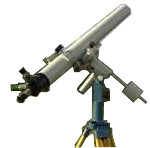 2. Refractor on manual Equatorial Mount – Zeiss Telementor II
2. Refractor on manual Equatorial Mount – Zeiss Telementor II
The telescope displayed in the hall is no longer available new, but was brought in to describe its manual equatorial mount and the differences compared to an alt-azimuth mount.
The movements of the equatorial mount were demonstrated.
Reference to the setting circles was made to show the way they are used to locate different objects in the sky.
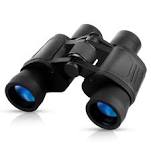 3. Binoculars
3. Binoculars
The internal optics of binoculars and the merits of different magnifications and size of objective lenses were described.
The size of the eyepieces relative to the darkness diameter of your pupil were also explained.
Image stabilised binoculars are much easier to use, but more expensive.
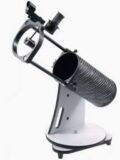 4. Newtonian Reflector – Skywatcher Heritage130p Dobsonian
4. Newtonian Reflector – Skywatcher Heritage130p Dobsonian
This is a lightweight, capable all-rounder which provides good views of both the Moon & Planets as well as Deep-Sky Objects.
The collapsible patented FlexTube™ system has been incorporated making it convenient to transport and store. The uncomplicated manually operated Dobsonian alt-azimuth mount makes it a highly portable system.
The complete telescope and mount comes fully assembled and straight out of the box.
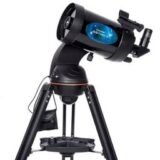 5. Catadioptric Reflector on GoTo Mount – Celestron Astro-Fi 5” Schmidt Cassegrain
5. Catadioptric Reflector on GoTo Mount – Celestron Astro-Fi 5” Schmidt Cassegrain
The Astro-Fi is a good all-rounder beginner computer controlled GoTo telescope which supports upgrades, including focal reducers, Barlow lenses, filters, GPS and Astro-Cameras.
It can be controlled from a Mobile Phone App, Tablet, Hand Controller or Computer.
The Optical Tube Assembly can be re-mounted onto an Equatorial mount for Astrophotography.
Be aware of the limitations and be prepared to spend extra on upgrades. There are now better options available that might suit the novice. Second hand will be a lot cheaper.
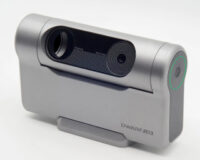 6. Smart Telescope – Dwarf 3
6. Smart Telescope – Dwarf 3
Smart telescopes are really digital cameras mounted on ALT-AZ mounts and they communicate via Bluetooth or WiFI to smart phones that act as an eyepiece.
Includes polar alignment, variable shutter speeds, IR and Dual band filters plus external sun filters, AI noise reduction and a built in night sky atlas.
Dwarf 3 also produces videos, panoramas, time lapse and simple photographs. Advantages are short setup time, relatively low cost, very lightweight (1.3kg), small size (222x142x65) and portable.
Prepared by Jim Worthington

